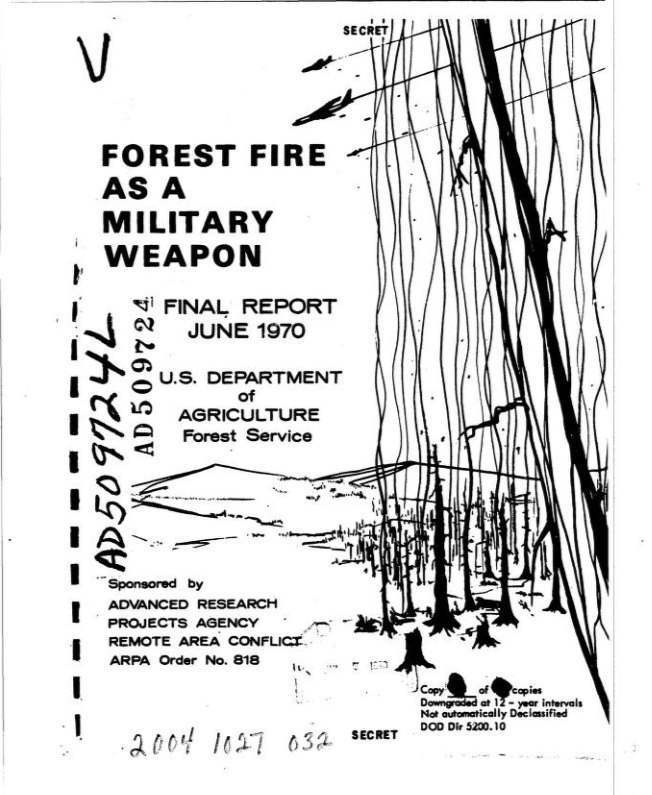|
In a startling revelation, recently declassified documents have brought to the forefront a chilling aspect of military strategy: the deliberate use of forest fires as weapons of war. Among these documents is a particularly intriguing report sponsored by the Defense Advanced Research Project Agency (DARPA) which delves into the potential applications of incendiary tactics in military operations. The document, published by the U.S. Department of Defense in 1970, outlines various techniques and scenarios wherein fires can be utilized to gain tactical advantages in combat situations. From creating smoke screens to obstruct enemy visibility to initiating large-scale forest fires to disrupt enemy supply lines and infrastructure, the report explores the myriad ways in which fire can be weaponized to achieve military objectives. Of particular concern is the section detailing the use of forest fires as a means of psychological warfare, wherein the intentional ignition of fires in enemy territory is aimed at instilling fear, confusion, and panic among civilian populations. By targeting forests, which are often integral to local ecosystems and communities, military planners sought to inflict not only physical damage but also psychological trauma, thereby undermining enemy morale and resolve. The implications of such tactics are profound, extending far beyond the immediate battlefield. Forest fires, once ignited, can rapidly escalate into uncontrollable infernos, engulfing vast expanses of land, devouring flora and fauna, and posing grave risks to human life and property. The indiscriminate nature of fire knows no bounds, sparing neither military targets nor civilian populations in its destructive path. Moreover, the use of forest fires as military weapons raises serious ethical and environmental concerns. The deliberate ignition of fires in densely forested areas not only poses immediate risks to human safety but also inflicts long-term damage to fragile ecosystems, biodiversity, and natural resources. The toll on wildlife habitats, air quality, water sources, and soil integrity can be irreparable, perpetuating ecological devastation for generations to come. In addition to the ecological ramifications, the revelation of forest fires being employed as military weapons underscores the nefarious tactics employed by elements within the so-called "deep state." This clandestine network, operating outside the purview of democratic oversight and accountability, is purportedly driven by ulterior motives and clandestine agendas that prioritize power and control over the welfare of people and planet. The use of forest fires as instruments of war epitomizes the callous disregard for human life, environmental stewardship, and international law exhibited by clandestine actors operating within the deep state. By weaponizing natural disasters for geopolitical gain, these shadowy forces perpetuate a cycle of destruction and suffering that reverberates far beyond the confines of the battlefield. In light of these revelations, it is incumbent upon governments, civil society organizations, and concerned citizens worldwide to demand transparency, accountability, and responsible stewardship in matters of national security and defense. The wanton destruction wrought by forest fires used as military weapons serves as a stark reminder of the urgent need for vigilance, oversight, and the safeguarding of our shared planet and its inhabitants. Only through collective action and unwavering commitment to peace, justice, and environmental preservation can we hope to mitigate the grave threats posed by the dark underbelly of militarism and covert warfare. Manipulating Climate Change NarrativesOne of the most insidious aspects of the use of forest fires as military weapons lies in the potential manipulation of climate change narratives for ulterior motives. In the wake of devastating fires, clandestine actors within the deep state may exploit the chaos and destruction to advance agendas aimed at consolidating control and power over the masses. By attributing forest fires to "climate change" and framing them as the result of extreme weather events purportedly exacerbated by human activity, these actors seek to justify intrusive policies and measures that encroach upon individual liberties and civil rights. This includes the implementation of carbon tracking and taxation systems, stringent environmental regulations, and centralized control over energy production and consumption. Under the guise of addressing climate-related emergencies, governments and supranational organizations may exploit public fear and uncertainty to expand their authority and influence, thereby furthering agendas of social engineering and population control. The narrative of impending environmental catastrophe serves as a pretext for imposing draconian measures that curtail freedom of movement, expression, and economic autonomy. Moreover, the misattribution of forest fires to climate change conveniently deflects attention away from the role of military actors in their deliberate ignition and propagation. By shifting blame to abstract concepts like "global warming" and "carbon emissions," covert agendas of militarization and geopolitical maneuvering remain obscured, allowing clandestine actors to operate with impunity and evade accountability. In this way, forest fires become not only tools of physical destruction but also instruments of psychological manipulation and social control. The exploitation of climate change narratives serves to perpetuate a climate of fear and dependency, wherein populations acquiesce to authoritarian measures in the name of environmental salvation. To combat such nefarious tactics, it is imperative that citizens remain vigilant, informed, and empowered to challenge official narratives and question the motives behind proposed policies and interventions. By advocating for transparency, accountability, and evidence-based decision-making, individuals can resist the manipulation of climate change narratives for political gain and safeguard democratic principles and human rights. In the face of converging crises – from environmental degradation to militarization and authoritarianism – solidarity, resilience, and collective action are paramount. Only through a concerted effort to expose and oppose covert agendas of manipulation and control can we hope to build a more just, equitable, and sustainable world for present and future generations. Directed EnergyOne of the most insidious aspects of the use of forest fires as military weapons lies in the speculation surrounding their origins, which range from natural causes to deliberate human intervention and even advanced technologies such as Directed Energy Weapons (DEWs). As fires rage through vast expanses of woodland, leaving devastation in their wake, questions abound regarding the true perpetrators behind these infernos. While conventional explanations point to factors like arson and lightning strikes, a growing body of evidence suggests the involvement of more clandestine actors with access to sophisticated weaponry and covert operations. Among the most concerning theories is the utilization of Directed Energy Weapons, capable of emitting highly focused energy beams to ignite and propagate fires over long distances with pinpoint accuracy. Instances such as the operations conducted by the Air Force Research Laboratory (AFRL) in Maui, where DEWs are tested and developed for military applications, have fueled speculation regarding their potential role in the creation of forest fires. Although the AFRL maintains that their research is aimed at enhancing national security and defense capabilities, concerns persist regarding the unintended consequences of deploying such technology in civilian environments. The prospect of military entities wielding Directed Energy Weapons to instigate or exacerbate forest fires raises profound ethical and legal questions about the use of force and the protection of civilian populations and natural habitats. In the absence of transparency and accountability, suspicions linger regarding the true intentions behind these operations and their impact on communities and ecosystems. Moreover, the intersection of DEW technology with narratives of climate change further complicates the discourse surrounding forest fires, as speculation abounds regarding the potential manipulation of environmental crises for geopolitical ends. By exploiting public fears and vulnerabilities, clandestine actors may seek to exploit the chaos and destruction wrought by fires to advance agendas of control and domination. In this volatile landscape of uncertainty and speculation, it becomes increasingly challenging to discern truth from deception and fact from fiction. As communities grapple with the aftermath of forest fires and the specter of future conflagrations looms large, it is imperative that rigorous investigation and scrutiny be applied to unraveling the complexities of these crises and holding accountable those responsible for their creation and escalation. Ultimately, the manipulation of forest fires for military purposes and the exploitation of climate change narratives for political gain represent grave threats to global stability and security. Only through vigilant oversight, informed discourse, and collective action can we hope to confront the multifaceted challenges posed by the weaponization of natural disasters and safeguard the well-being of humanity and the planet. references“Directed Energy – Air Force Research Laboratory.” Afresearchlab.com, afresearchlab.com/technology/directed-energy/.
Defense Technical Information Center. DTIC AD0509724: Forest Fire as a Military Weapon. Internet Archive, US Department of Agriculture Forest Service, 1 June 1970, archive.org/details/DTIC_AD0509724/page/n1/mode/2up?view=theater.
0 Comments
|
This feed contains research, news, information, observations, and ideas at the level of the world.
Archives
May 2024
Categories
All
|



 RSS Feed
RSS Feed

